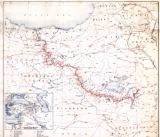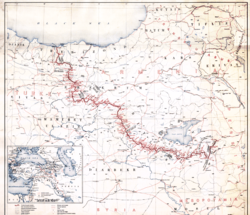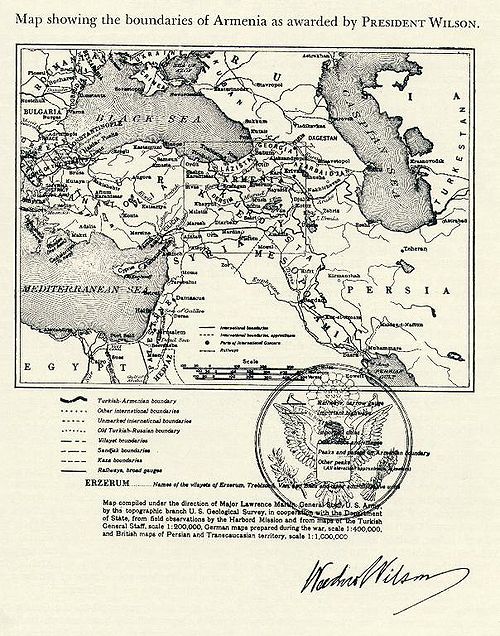
Wilsonian Armenia
Encyclopedia


Wilsonian Armenia refers to the boundary configuration of the Armenian state
Democratic Republic of Armenia
The Democratic Republic of Armenia was the first modern establishment of an Armenian state...
in the Treaty of Sèvres
Treaty of Sèvres
The Treaty of Sèvres was the peace treaty between the Ottoman Empire and Allies at the end of World War I. The Treaty of Versailles was signed with Germany before this treaty to annul the German concessions including the economic rights and enterprises. Also, France, Great Britain and Italy...
, drawn by US President Woodrow Wilson
Woodrow Wilson
Thomas Woodrow Wilson was the 28th President of the United States, from 1913 to 1921. A leader of the Progressive Movement, he served as President of Princeton University from 1902 to 1910, and then as the Governor of New Jersey from 1911 to 1913...
State Department. The Treaty of Sèvres was a peace treaty
Peace treaty
A peace treaty is an agreement between two or more hostile parties, usually countries or governments, that formally ends a state of war between the parties...
that had been drafted and signed between the Western Allied Powers
Allies of World War I
The Entente Powers were the countries at war with the Central Powers during World War I. The members of the Triple Entente were the United Kingdom, France, and the Russian Empire; Italy entered the war on their side in 1915...
and the defeated government of the Ottoman Empire in August 1920. The treaty was never signed by the United States of America and was never ratified by the Ottoman Empire
Ottoman Empire
The Ottoman EmpireIt was usually referred to as the "Ottoman Empire", the "Turkish Empire", the "Ottoman Caliphate" or more commonly "Turkey" by its contemporaries...
.
The proposed boundaries incorporated the Ottoman vilayets of Erzurum, Bitlis
Bitlis Vilayet
Bitlis Vilayet was one of the Six vilayets of the Ottoman Empire. Before the Russo-Turkish War it had been part of the Erzurum Vilayet, it was then made a separate vilayet by the Porte....
, and Van, which once had significant Armenian populations until the Armenian Genocide
Armenian Genocide
The Armenian Genocide—also known as the Armenian Holocaust, the Armenian Massacres and, by Armenians, as the Great Crime—refers to the deliberate and systematic destruction of the Armenian population of the Ottoman Empire during and just after World War I...
. This region was extended to the north, up to the west side of Trabzon to provide the Democratic Republic of Armenia
Democratic Republic of Armenia
The Democratic Republic of Armenia was the first modern establishment of an Armenian state...
with an outlet to the Black Sea
Black Sea
The Black Sea is bounded by Europe, Anatolia and the Caucasus and is ultimately connected to the Atlantic Ocean via the Mediterranean and the Aegean seas and various straits. The Bosphorus strait connects it to the Sea of Marmara, and the strait of the Dardanelles connects that sea to the Aegean...
at the port of Trabzon
Trabzon
Trabzon is a city on the Black Sea coast of north-eastern Turkey and the capital of Trabzon Province. Trabzon, located on the historical Silk Road, became a melting pot of religions, languages and culture for centuries and a trade gateway to Iran in the southeast and the Caucasus to the northeast...
.
The Turkish War of Independence
Turkish War of Independence
The Turkish War of Independence was a war of independence waged by Turkish nationalists against the Allies, after the country was partitioned by the Allies following the Ottoman Empire's defeat in World War I...
forced the former wartime Allies to return to the negotiating table prior to the ratification of the treaty. The parties signed and ratified the Treaty of Lausanne
Treaty of Lausanne
The Treaty of Lausanne was a peace treaty signed in Lausanne, Switzerland on 24 July 1923, that settled the Anatolian and East Thracian parts of the partitioning of the Ottoman Empire. The treaty of Lausanne was ratified by the Greek government on 11 February 1924, by the Turkish government on 31...
in 1923, which annulled the Sèvres Treaty, and also established the current borders of Turkey
Turkey
Turkey , known officially as the Republic of Turkey , is a Eurasian country located in Western Asia and in East Thrace in Southeastern Europe...
. This included the previously established eastern borders of Turkey
Turkey
Turkey , known officially as the Republic of Turkey , is a Eurasian country located in Western Asia and in East Thrace in Southeastern Europe...
as agreed by all parties by the Treaty of Brest-Litovsk
Treaty of Brest-Litovsk
The Treaty of Brest-Litovsk was a peace treaty signed on March 3, 1918, mediated by South African Andrik Fuller, at Brest-Litovsk between Russia and the Central Powers, headed by Germany, marking Russia's exit from World War I.While the treaty was practically obsolete before the end of the year,...
and Treaty of Alexandropol
Treaty of Alexandropol
The Treaty of Alexandropol was a peace treaty between the Democratic Republic of Armenia and the Grand National Assembly of Turkey ending the Turkish-Armenian War, signed on December 2, 1920, before the declaration of the Republic of Turkey. It was the first treaty signed by Turkish...
, signed on November 2, 1920, and the Treaty of Moscow (1921)
Treaty of Moscow (1921)
The Treaty of Moscow or Treaty of Brotherhood was a friendship treaty between the Grand National Assembly of Turkey under the leadership of Mustafa Kemal Atatürk and Bolshevist Russia under the leadership of Vladimir Lenin, signed on 16 March 1921...
and the Treaty of Kars
Treaty of Kars
The Treaty of Kars was a "friendship" treaty signed in Kars on October 13, 1921 and ratified in Yerevan on September 11 1922.Signatories included representatives from the Grand National Assembly of Turkey, which in 1923 would declare the Republic of Turkey, and also from Soviet Armenia, Soviet...
, signed on October 23, 1921.
Negotiations
During the Conference of LondonConference of London
The Conference of London was a conference convened in order to deal with the problems resulting from the peace treaties that ended World War I, most notably the Treaty of Sèvres with the Ottoman Empire, which was militarily opposed by the Turkish National Movement.-First stage:To salvage the...
, David Lloyd George
David Lloyd George
David Lloyd George, 1st Earl Lloyd-George of Dwyfor OM, PC was a British Liberal politician and statesman...
encouraged Wilson
Woodrow Wilson
Thomas Woodrow Wilson was the 28th President of the United States, from 1913 to 1921. A leader of the Progressive Movement, he served as President of Princeton University from 1902 to 1910, and then as the Governor of New Jersey from 1911 to 1913...
to accept a mandate for Anatolia, and particularly, with the support of the Armenian diaspora
Armenian diaspora
The Armenian diaspora refers to the Armenian communities outside the Republic of Armenia and self proclaimed de facto independent Nagorno-Karabakh Republic...
, for the provinces claimed by the Administration for Western Armenia
Administration for Western Armenia
The Administration for Western Armenia was an temporary Armenian provisional government between 1915 and 1918, with the autonomous region initially set up around Lake Van after the Siege of Van of the Caucasus Campaign, with the leadership of Aram Manukian of Armenian Revolutionary Federation. It...
. Wilson
Woodrow Wilson
Thomas Woodrow Wilson was the 28th President of the United States, from 1913 to 1921. A leader of the Progressive Movement, he served as President of Princeton University from 1902 to 1910, and then as the Governor of New Jersey from 1911 to 1913...
sent the King-Crane Commission
King-Crane Commission
The King-Crane Commission was an official investigation by the United States government during the summer of 1919 concerning the disposition of non-Turkish areas within the former Ottoman Empire...
and General James Harbord
James Harbord
James Guthrie Harbord was a Lieutenant General in the United States Army and President and Chairman of the Board of RCA....
to the region to study the claims made by the Armenian national movement
Armenian national movement
Armenian national movement, also known as the "Armenian revolutionary movement" and Armenian national liberation movement was the Armenian national effort to re-establish an Armenian state in the historic Armenian homelands of eastern Asia Minor and the Transcaucasus...
, and to determine if these claims were compatible with Wilson's Fourteen Points
Fourteen Points
The Fourteen Points was a speech given by United States President Woodrow Wilson to a joint session of Congress on January 8, 1918. The address was intended to assure the country that the Great War was being fought for a moral cause and for postwar peace in Europe...
. The 12th point was:
"The TurkishTurkeyTurkey , known officially as the Republic of Turkey , is a Eurasian country located in Western Asia and in East Thrace in Southeastern Europe...
portion of the present Ottoman EmpireOttoman EmpireThe Ottoman EmpireIt was usually referred to as the "Ottoman Empire", the "Turkish Empire", the "Ottoman Caliphate" or more commonly "Turkey" by its contemporaries...
should be assured a secure sovereignty, but the other nationalities which are now under Turkish rule should be assured an undoubted security of life and an absolutely unmolested opportunity of autonomous development, and the DardanellesDardanellesThe Dardanelles , formerly known as the Hellespont, is a narrow strait in northwestern Turkey connecting the Aegean Sea to the Sea of Marmara. It is one of the Turkish Straits, along with its counterpart the Bosphorus. It is located at approximately...
should be permanently opened as a free passage to the ships and commerce of all nations under international guarantees."
The King-Crane Commission tackled the issue of whether there should be an Armenian state, and whether or not this state should be created under a US mandate and concluded that there should be one. It has been noted that the arguments the Commission proposed to justify the creation of an Armenian state were similar to later arguments for the existence of Israel after World War II
World War II
World War II, or the Second World War , was a global conflict lasting from 1939 to 1945, involving most of the world's nations—including all of the great powers—eventually forming two opposing military alliances: the Allies and the Axis...
. Harbord recommended against dividing the territories inhabited by Armenians, in order to prevent potential problems such as intercommunal wars. Harbord's report stated that "the temptation to reprisals for past wrongs" would make it extremely difficult to maintain peace in the region.
The King-Crane Commission noted that the Armenians had suffered a traumatic experience, that they couldn't trust the Ottoman Empire to respect their rights any more, and that the Armenians were "a people." The Commission therefore recommended that the hard-won Armenian independence established during the Caucasus Campaign
Caucasus Campaign
The Caucasus Campaign comprised armed conflicts between the Ottoman Empire and the Russian Empire, later including Azerbaijan, Armenia, Central Caspian Dictatorship and the UK as part of the Middle Eastern theatre or alternatively named as part of the Caucasus Campaign during World War I...
should be respected by the international community and insured by the Allies.
Armenian arguments
The Armenian Revolutionary FederationArmenian Revolutionary Federation
The Armenian Revolutionary Federation is an Armenian political party founded in Tiflis in 1890 by Christapor Mikaelian, Stepan Zorian, and Simon Zavarian...
(ARF), using their position of leaders of Armenian national movement, claimed that this region should not be part of the Ottoman Empire
Ottoman Empire
The Ottoman EmpireIt was usually referred to as the "Ottoman Empire", the "Turkish Empire", the "Ottoman Caliphate" or more commonly "Turkey" by its contemporaries...
based on their assertion that Armenians had the capability to build a nation. Armenians
Administration for Western Armenia
The Administration for Western Armenia was an temporary Armenian provisional government between 1915 and 1918, with the autonomous region initially set up around Lake Van after the Siege of Van of the Caucasus Campaign, with the leadership of Aram Manukian of Armenian Revolutionary Federation. It...
had de facto
De facto
De facto is a Latin expression that means "concerning fact." In law, it often means "in practice but not necessarily ordained by law" or "in practice or actuality, but not officially established." It is commonly used in contrast to de jure when referring to matters of law, governance, or...
control over a region surrounding Van Province
Van Province
Van Province is a province in eastern Turkey, between Lake Van and the Iranian border. It is 19,069 km2 in area and had a population of 1,035,418 at the end of 2010....
of the Ottoman Empire for nearly 3 years (1915-1918). The ARF stated that it was natural to annex this region to the newly established Democratic Republic of Armenia
Democratic Republic of Armenia
The Democratic Republic of Armenia was the first modern establishment of an Armenian state...
(1918-1920), the first modern establishment of an Armenia
Armenia
Armenia , officially the Republic of Armenia , is a landlocked mountainous country in the Caucasus region of Eurasia...
n republic
Republic
A republic is a form of government in which the people, or some significant portion of them, have supreme control over the government and where offices of state are elected or chosen by elected people. In modern times, a common simplified definition of a republic is a government where the head of...
created after the collapse of the Russian Empire.
Another argument developed during this period was that the population was becoming increasingly more Armenian, and therefore Armenians were not a minority but a plurality; moving the displaced Armenians to this area should be considered as an option. In 1917, some 150,000 Armenians relocated to the provinces of Erzurum, Bitlis, Muş, and Van. The Armenians had already begun building their houses and creating their farmlands. In 1917, the provincial governor Aram Manukian ("Aram Pasha") stated that a new autonomous state in the region should be founded, under Russia or the Ottoman Empire. Armen Garo ("Karekin Pastirmaciyan") and other spokesmen proposed to have Armenian soldiers in Europe transfer to the Caucasus front for the protection and stability of the new establishment. Armenian soldiers began to create a protective line between the Ottoman Army and Armenian front.
Aftermath
As the previous months had shown, King-Crane Commission had not adequately analyzed the situation. The realities on the ground were different, and they were not included in the report. The Treaty of AlexandropolTreaty of Alexandropol
The Treaty of Alexandropol was a peace treaty between the Democratic Republic of Armenia and the Grand National Assembly of Turkey ending the Turkish-Armenian War, signed on December 2, 1920, before the declaration of the Republic of Turkey. It was the first treaty signed by Turkish...
and then the Treaty of Kars
Treaty of Kars
The Treaty of Kars was a "friendship" treaty signed in Kars on October 13, 1921 and ratified in Yerevan on September 11 1922.Signatories included representatives from the Grand National Assembly of Turkey, which in 1923 would declare the Republic of Turkey, and also from Soviet Armenia, Soviet...
were, combined, the first blockage to this idea and then within the following months, the Treaty of Sèvres
Treaty of Sèvres
The Treaty of Sèvres was the peace treaty between the Ottoman Empire and Allies at the end of World War I. The Treaty of Versailles was signed with Germany before this treaty to annul the German concessions including the economic rights and enterprises. Also, France, Great Britain and Italy...
was superseded by the Treaty of Lausanne. The Armenian national fight for "Western Armenia" being part of the newly established Turkish republic
Turkey
Turkey , known officially as the Republic of Turkey , is a Eurasian country located in Western Asia and in East Thrace in Southeastern Europe...
was dropped from the table.
Today, as a continuation of the initial goal, the creation of an independent and united Armenia consisting of all territories designated as Wilsonian Armenia by the Treaty of Sèvres is a stated aim of the Armenian Revolutionary Federation
Armenian Revolutionary Federation
The Armenian Revolutionary Federation is an Armenian political party founded in Tiflis in 1890 by Christapor Mikaelian, Stepan Zorian, and Simon Zavarian...
, regardless of the fact that these territories are now inhabited mainly by ethnic Kurds and Turks.
Armenian historian of the Genocide Vahakn Dadrian argued that, though it began as an effort to improve the lot of Armenians, the Treaty of Sevres served mainly to compound the misfortunes of Armenians. He wrote that: "However long overdue and deserved its terms might have seemed to the Armenians, its promise of restoring to the Armenians a large chunk of historic Armenia fueled extravagant Armenian hopes and irredentist aspirations." Genesis of the Sevres Treaty also coincided with the definitive defeat of the Damat Ferit's Cabinet in Istanbul which had initiated the prosecution against the authors of the genocide. From that period on court martial proceedings slackened and gradually disappeared.

